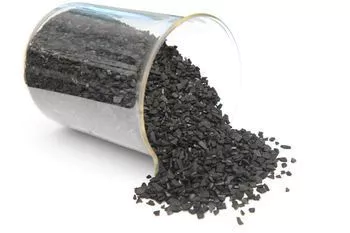Description
Activated carbon, also called activated charcoal, is a form of carbon processed to have small, low-volume pores that increase the surface area available for adsorption or chemical reations. Activated is sometimes substituted with active.
Due to its high degree of microporosity, one gram of activated carbon has a surface area in excess of 3,000 m2 (32,000 sq ft) as determined by gas adsorption. An activation level sufficient for useful application may be obtained solely from high surface area. Further chemical treatment often enhances adsorption properties.
Activated carbons are manufactured from coconut shell, peat, hard and soft wood, lignite coal, bituminous coal, olive pits and various specialty materials. Manufactured by chemical or high temperature steam activation
Uses
Activated carbon is used in methane and hydrogen storage, air purification, decaffeination, gold purification, metal extraction, water purification, medicine, sewage treatment, air filters in gas masks and respirators, filters in compressed air, teeth whitening, and many other applications.
Production
Activated carbon is carbon produced from carbonaceous source materials such as bamboo, coconut husk, willow peat, wood, coir, lignite, coal, and petroleum pitch. It can be produced by one of the following processes:
Physical activation: The source material is developed into activated carbons using hot gases. Air is then introduced to burn out the gasses, creating a graded, screened and de-dusted form of activated carbon. This is generally done by using one or a combination of the following processes:
Carbonization: Material with carbon content is pyrolyzed at temperatures in the range 600–900 °C, usually in inert atmosphere with gases like argon or nitrogen
Activation/Oxidation: Raw material or carbonized material is exposed to oxidizing atmospheres (oxygen or steam) at temperatures above 250 °C, usually in the temperature range of 600–1200 °C.
Chemical activation: Prior to carbonization, the raw material is impregnated with certain chemicals. The chemical is typically an acid, strong base, or a salt (phosphoric acid, potassium hydroxide, sodium hydroxide, calcium chloride, and zinc chloride 25%). Then, the raw material is carbonized at lower temperatures (450–900 °C). It is believed that the carbonization / activation step proceeds simultaneously with the chemical activation.[clarification needed] Chemical activation is preferred over physical activation owing to the lower temperatures and shorter time needed for activating material.
- Activated Carbon
- Coconut Shell Activated Carbon
Production Capacity:
1000 MT
Delivery Timeframe:
Within 1 Year
Incoterms:
CFR - Cost and Freight
CIF - Cost, Insurance and Freight
FOB - Free on Board
Packaging Details:
25 kg, 50 kg
More about
Anurag Carbon
0-10
Employees
100K - 200K
Sales volume (USD)
100%
% Export sales
Year
Established
Business type
- Industry / Manufacturer
- Importer / Trading Company
Keywords
- Activated Carbon
Contact and location
-
Anurag Tiwari
-
+91 512 xxxxxxxx
-
Kanpur / SE | India





